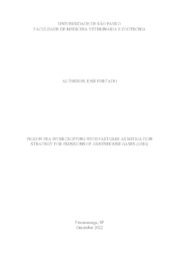Pigeon pea intercropping with pastures as mitigation strategy for emissions of greenhouse gases (GHG).
Pigeon pea intercropping with pastures as mitigation strategy for emissions of greenhouse gases (GHG).
Author(s): FURTADO, A. J.
Summary: Brazil has one of the largest cattle herds in the world, with approximately 224 million heads and the enteric methane (CH4) emitted by ruminants is one of the main greenhouse gases (GHG). Therefore, strategies to mitigate CH4 emissions have been studied and implemented. The recovery and intensification of pastures and intercropping tropical pastures with legumes are some of the practices that have potential to mitigate GHG emissions. The objective of this study was to evaluate the effects of intercropping pigeon pea (Cajanus cajan) with tropical pastures for feeding Nellore cattle and to compare performance variables and enteric CH4 emissions with other pasture-based systems during the dry and rainy seasons of 2021. The study was carried out at Embrapa Pecuária Sudeste, in São Carlos, SP, in two distinct seasons of 2021: rainy (January) and dry (July). Thirty-six Nellore steers (221 ± 10 kg of body weight and 15-16 months) were randomly distributed in three treatments with three replicates (paddocks 1.5 hectares each): 1) a degraded pasture of Urochloa decumbens cv. Basilisk (DEG); 2) a recovered and fertilized (200 kg N ha-1 year-1) pasture stablished with U. decumbens cv. Basiliskand U. brizantha cv. Marandu (REC); and 3) a intercropped of tropical grasses ( U. decumbens cv. Basilisk and U. brizantha cv. Marandu) and the legume pigeon pea ( Cajanus cajan L. Millsp. cv. BRS Mandarim) (MIX). CH4 emissions were estimated using the sulfur hexafluoride (SF6) tracer gas technique and dry matter intake (DMI) determined using internal (iNDF indigestible neutral detergent fiber) and external (TiO2 titanium dioxide) markers. Forages were collected by hand plucking using the methodology of grazing simulation with observations of ingestive behavior, and feces were collected after voluntary defecation. The nutritional quality of the forages was determined, animal performance was monthly monitored, and the stocking rate adjusted by the put and take technique. The statistical model considered treatments and seasons as fixed effects, and the interaction treatment×season was tested. Data were subjected to analysis of variance and mean compared by Fisher test at 5% significance level in SAS software. The results indicate that intercropping pigeon pea with tropical grasses is an interesting strategy for sustainable livestock production based on pastures. In the MIX treatment the forage presented better nutritional composition, the animals consumed less mineral supplement while presenting better animal performance. In addition, there was a reduction in CH4 emissions up to 70% when expressed per average daily weight gain in comparison to DEG treatment.
Publication year: 2022
Types of publication: Theses
Keywords: Bovino, Brachiaria, Cajanus Cajan, Capim Urochloa, Metano
Observation
Some of Embrapa's publications are published as ePub files. To read them, use or download one of the following free software options to your computer or mobile device. Android: Google Play Books; IOS: iBooks; Windows and Linux: Calibre.
Access other publications
Access the Agricultural Research Database (BDPA) to consult Embrapa's full library collection and records.
Visit Embrapa Bookstore to purchase books and other publications sold by Embrapa.

